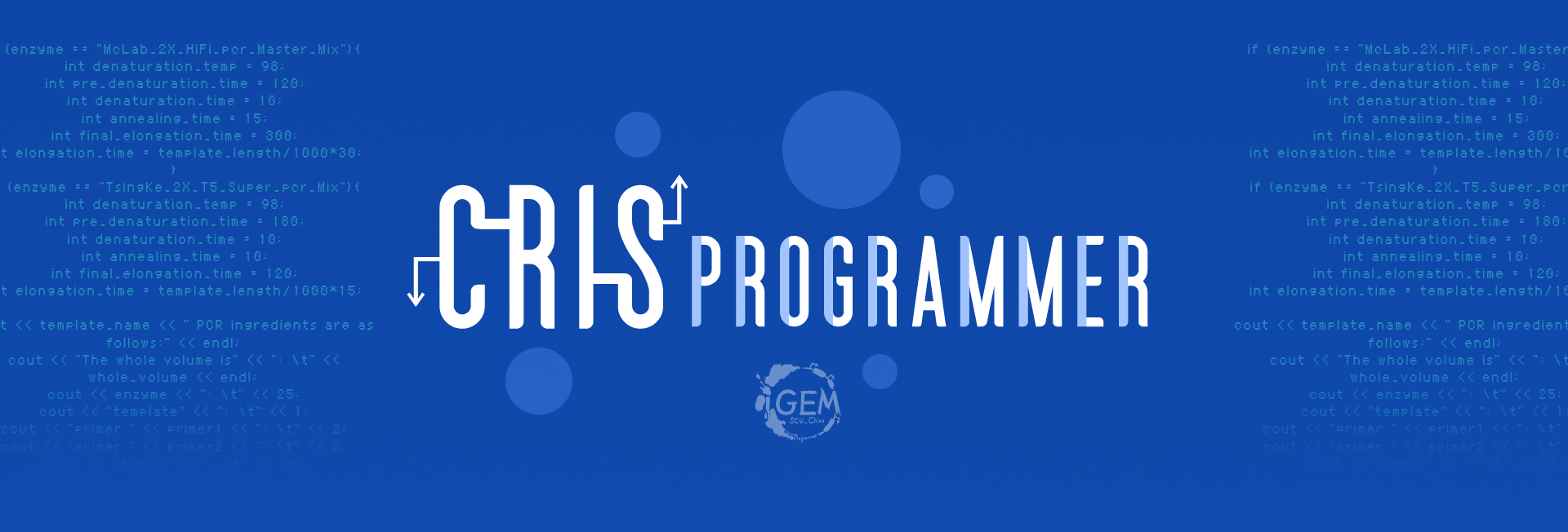
Overview
Huge scale of our experimental design based firmly on modelling results. Our Model can be divided into two parts, each has significant function in guiding the direction of our whole design, and the future work. Inspired by the modelling results, our team can optimize the experiment without wasting our time. Besides, the results help us to make the system stable and feasible.
Mismatch
Why we did this model?
1) The gradient regulation just based on some experiments focusing on the efficiency of sgRNA. No essay shows particular results and specialized experiment about the idea. It’s quite risky for us to have a try, no matter how fascinating the idea is. As a result, we should confirm its feasibility at first.
2) So many factors will influence the binding between the sgRNA-dCas9 complex with targeted DNA region. The hydrogen bound between bases, the specificity of sgRNA, the three-dimension structure of sgRNA scaffold. Before we start our experiment, we should consider all likely elements which have an effect on the results as thorough as possible. In order to save time, and generalize all the condition, the model stands out to be a perfect method.
3) The construction of mismatch sequence library is a huge work. With only two months to finish our project, it does not look like pragmatic to verify the idea by experiment.
2) So many factors will influence the binding between the sgRNA-dCas9 complex with targeted DNA region. The hydrogen bound between bases, the specificity of sgRNA, the three-dimension structure of sgRNA scaffold. Before we start our experiment, we should consider all likely elements which have an effect on the results as thorough as possible. In order to save time, and generalize all the condition, the model stands out to be a perfect method.
3) The construction of mismatch sequence library is a huge work. With only two months to finish our project, it does not look like pragmatic to verify the idea by experiment.
How was our model constructed?
Here in our model, the effects of the following factors are considered on the off-target mutation. 1. The position of base mismatch: studies show that the closer the mismatch is to the PAM site, the easier it is to cause off-target effect; 2. The number of base mismatches; 3. The continuous base mismatches; 4. Thermodynamics structure relationship of mismatches: different base mismatches often require different energies. For example, stability enhancement for rG : dT mismatch is the highest of all mismatches;
With the help of the experimental data published by Evan, and the design of our own sgRNA (design through the general workflow, Figure 1), we encode all the base sequences according to the mismatch type and the energy intensity between the mismatched bases, on the basis of which the depth neural network with multi-layer perceptron is established and trained.
With the help of the experimental data published by Evan, and the design of our own sgRNA (design through the general workflow, Figure 1), we encode all the base sequences according to the mismatch type and the energy intensity between the mismatched bases, on the basis of which the depth neural network with multi-layer perceptron is established and trained.

What did the modeling tell us?
When the mutations happen on seed region, the repression level is persistently low. While the mismatches happen on off-seed region, once the amounts of that live up to 3, the repression level slumps immediately. Unfortunately, it seems the mismatch strategy cannot work perfectly like our team wanted based on the modeling results. Thus, we turn to other alternatives to achieve the goal.
Orthogonality
Why we did this model?
1) In both basic logic circuits and more complex logic circuits, there are definitely more than one kind of sgRNA function in a cell simultaneously. To reduce the crosstalk to the maximum extent, we should insure the specificity of sgRNA.
2) For our versatile promotor, the orthogonality is an all-important factor to make sure the stable and accuracy of regulation. We must filter the genome and plasmid backbone sequence, getting rid of futile targeting.
2) For our versatile promotor, the orthogonality is an all-important factor to make sure the stable and accuracy of regulation. We must filter the genome and plasmid backbone sequence, getting rid of futile targeting.
How was our model constructed?
We used a specific algorithm to generate a set of orthogonal sgRNAs.
What did the modeling tell us?
The output of the algorithm is a set of orthogonal sgRNAs. By using the sgRNAs, we construct our versatile promoters – spacer sequence containing promoters. And the sgRNAs can be used in targeting correspondent DNA orthogonally.
